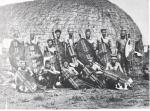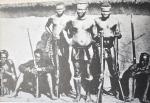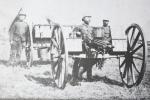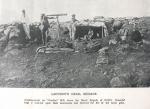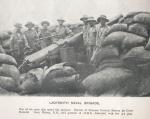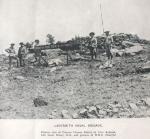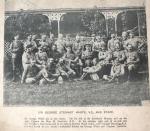-
Posts
13,225 -
Joined
-
Last visited
-
Days Won
22
Content Type
Profiles
Forums
Blogs
Gallery
Events
Store
Everything posted by Mervyn Mitton
-

1877 Romanian War of Independance Turkish Bayonet.
Mervyn Mitton replied to Kev in Deva's topic in Swords & Edged Weapons
Hi - Kev. This is interesting - looks as if it were to fit a muzzle loader with the slip-on attachment.** Any idea what they were using at that time ? Certainly in excavated condition and at some time it looks as if they have been cutting wood - the usual culprit for such blade damage. You say Turkish bayonet - perhaps for a Mauser ? ** But then so did our Martini Henry of the same period. -
Pat - I agree with Brian, you are most probably right that it originates from later in the War, when standards had been amended. People will put their swords back in scabbards when they are wet from rain- and this leads to the bottom few inches -cm- becoming rusted and blackened. Try a good gun oil on the rust sections. The black painted scabbards are always a problem - the paint chips and comes away. I know everyone is anxious never to touch anything - however, at the end of the day - if a properly applied coat of paint can restore the appearance, then it has to be a personal decision. The emblems make the WW2 blades sought after - they are not terribly valuable. Still, nice to have in a collection.
-

My collections framed: Thai Awards
Mervyn Mitton replied to khorgor's topic in South East & East Asia
Khorgor - well done. The Thai Order is a particularly nice one and the bullion embroidery excellent - I suspect this may be an old award, the quality is so good. If I ever find my Order of the White Elephant - 5th class ( I was given it for blood donations!) you can have it - however, I am not sure where it is now. -
I have checked the 'search' section for British medal ribbons and it does not show any - apart from some groups and singles. In view of Lukascz' question on George 6th. I am posting these cards from pre-WW2. They show some of the more common ones that we are likely to come across and this will provide a thread where we can add. Eventually this could be a section for quick reference. The Medal Year Book has some of the best lists of Medal Ribbons - however, not everyone has access. I am not sure we should copy them in case of Copyright. We need WW2 and post war ribbons + your own references.
-

Artillery piece for identification please
Mervyn Mitton replied to coldstream's topic in Armour, Vehicles, Ships & Aircraft
I'm going to play 'devil's advocate' ! Under wartime conditions normal practises tend to fall away and I think Harvey may well be right that they are cleaning the barrel. The normal rod may have been lost and no way to be replaced in the field. The circular metal shield with cutout for the barrel looks as if it is to protect the gunners if it were to be used in an exposed area - but, obviously not required in a tight little bunker. I don't understand why no one is shown - usually they all want to be in the picture..... I agree with German - too untidy for British ! -

Weapons Collectors' Bonanza
Mervyn Mitton replied to Harry Fecitt's topic in Police Forces of the World
Brett - you're just an old cynic....... But, seriously, I think that we would be hard put to defend ourselves agaist the Isle of Wight ! -
Many Zulus - who lived away from the Ulundi area in Northern Natal were quite happy to join the British as guides, bearers and as warriors. We raised a number of Zulu regiments and levies - however, when they came-up against the Zulu Impis - as they did at Isandlawana, they became a handicap. This photo shows a group of these warriors - you will see that they are wearing similar clothing and carrying the same weapons. Interestingly, the front cover for the genitals is called a Nene. We have shown many examples in our general Zulu post. During warfare it is reported that they tended to shorten the Nene - perhaps for easier movement. However, many troops reported that younger Zulus would expose themselves to their enemy, before going into the fight. Perhaps a 'sign of dis-respect' ?
-
Right - I think we can safely move back to the Zulus and their weaponry. This next picture shows the King's half-brother Dubalamanzi. He was a rather impetuous man with a bad temper, and did not take kindly to being given command of only three impis at Isandlawana and being told to go around the back of the mountain to cut off retreat. This lead him to go against the King's orders that Zulu Forces should not cross the Buffalo River. He wanted a share of the 'glory' and directly attacked Rorke's Drift. However, that will be a separate post at another time. You will see that the men with him - as well as himself - are all carrying Martini Henry rifles. These were taken from dead British soldiers and for a period of time the Zulus had more of them then we did ! That's what happens when you lose a major battle. You will note that Dubalamanzi and one of the men on his left, are both wearing the Isicoco - or, headring. This was granted by the King to men who had reached maturity - usually in their 40's. It was made by letting the hair grow and then rolling it into a 'ring shape' with animal fat. It set like a piece of iron and remained until death. Sadly a bounty (reward) was set on these by British Authorities - rather like the Native Americans in the 19th. C.
-
I have just finished reading an excellent book on the Anglo-Zulu War - by Alan Lloyd it is called the Zulu War 1879 and was first published in 1973.The next three pictures are from this book. I was reminded that whilst I covered weapons for British Officers' and enlisted men - I overlooked our heavier weapons. Basically, we were using 7 lbs. muzzle loading cannon - and two that fought at Isandlawana are still in the Transvaal on display. Also, at Isandlawana was a Rocket Battery - they were not a success and all were killed. The last battle was at Ulundi - the King's capital and here we introduced something quite different - Gatling Guns. The Battery that was in the Square was the first to be equipped with them and they proved to be quite effective. They fired bullets from a drum attached overhead - and a handle was turned at a regular pace to fire them. They were in effect the first machine guns.
-

one of my last research projects
Mervyn Mitton replied to Noor's topic in Great Britain: Orders, Gallantry, Campaign Medals
Timo - a very nice trio and you have some excellent research. This would be a centrepiece in any collection. Did you buy the Group locally ? -
-








